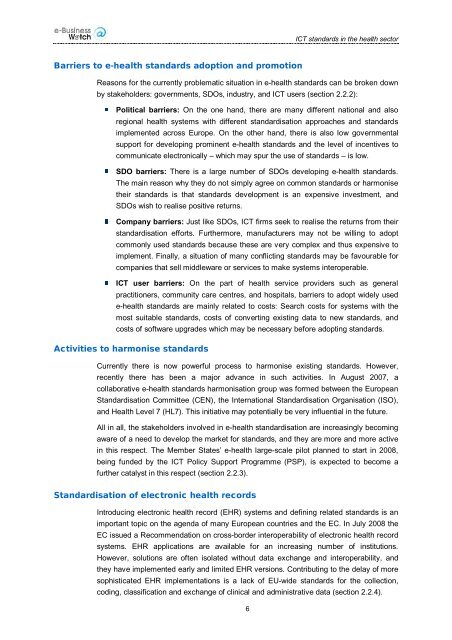ICT standards in the health sector: current situation and ... - empirica
ICT standards in the health sector: current situation and ... - empirica
ICT standards in the health sector: current situation and ... - empirica
You also want an ePaper? Increase the reach of your titles
YUMPU automatically turns print PDFs into web optimized ePapers that Google loves.
<strong>ICT</strong> <strong>st<strong>and</strong>ards</strong> <strong>in</strong> <strong>the</strong> <strong>health</strong> <strong>sector</strong>Barriers to e-<strong>health</strong> <strong>st<strong>and</strong>ards</strong> adoption <strong>and</strong> promotionReasons for <strong>the</strong> <strong>current</strong>ly problematic <strong>situation</strong> <strong>in</strong> e-<strong>health</strong> <strong>st<strong>and</strong>ards</strong> can be broken downby stakeholders: governments, SDOs, <strong>in</strong>dustry, <strong>and</strong> <strong>ICT</strong> users (section 2.2.2):Political barriers: On <strong>the</strong> one h<strong>and</strong>, <strong>the</strong>re are many different national <strong>and</strong> alsoregional <strong>health</strong> systems with different st<strong>and</strong>ardisation approaches <strong>and</strong> <strong>st<strong>and</strong>ards</strong>implemented across Europe. On <strong>the</strong> o<strong>the</strong>r h<strong>and</strong>, <strong>the</strong>re is also low governmentalsupport for develop<strong>in</strong>g prom<strong>in</strong>ent e-<strong>health</strong> <strong>st<strong>and</strong>ards</strong> <strong>and</strong> <strong>the</strong> level of <strong>in</strong>centives tocommunicate electronically – which may spur <strong>the</strong> use of <strong>st<strong>and</strong>ards</strong> – is low.SDO barriers: There is a large number of SDOs develop<strong>in</strong>g e-<strong>health</strong> <strong>st<strong>and</strong>ards</strong>.The ma<strong>in</strong> reason why <strong>the</strong>y do not simply agree on common <strong>st<strong>and</strong>ards</strong> or harmonise<strong>the</strong>ir <strong>st<strong>and</strong>ards</strong> is that <strong>st<strong>and</strong>ards</strong> development is an expensive <strong>in</strong>vestment, <strong>and</strong>SDOs wish to realise positive returns.Company barriers: Just like SDOs, <strong>ICT</strong> firms seek to realise <strong>the</strong> returns from <strong>the</strong>irst<strong>and</strong>ardisation efforts. Fur<strong>the</strong>rmore, manufacturers may not be will<strong>in</strong>g to adoptcommonly used <strong>st<strong>and</strong>ards</strong> because <strong>the</strong>se are very complex <strong>and</strong> thus expensive toimplement. F<strong>in</strong>ally, a <strong>situation</strong> of many conflict<strong>in</strong>g <strong>st<strong>and</strong>ards</strong> may be favourable forcompanies that sell middleware or services to make systems <strong>in</strong>teroperable.<strong>ICT</strong> user barriers: On <strong>the</strong> part of <strong>health</strong> service providers such as generalpractitioners, community care centres, <strong>and</strong> hospitals, barriers to adopt widely usede-<strong>health</strong> <strong>st<strong>and</strong>ards</strong> are ma<strong>in</strong>ly related to costs: Search costs for systems with <strong>the</strong>most suitable <strong>st<strong>and</strong>ards</strong>, costs of convert<strong>in</strong>g exist<strong>in</strong>g data to new <strong>st<strong>and</strong>ards</strong>, <strong>and</strong>costs of software upgrades which may be necessary before adopt<strong>in</strong>g <strong>st<strong>and</strong>ards</strong>.Activities to harmonise <strong>st<strong>and</strong>ards</strong>Currently <strong>the</strong>re is now powerful process to harmonise exist<strong>in</strong>g <strong>st<strong>and</strong>ards</strong>. However,recently <strong>the</strong>re has been a major advance <strong>in</strong> such activities. In August 2007, acollaborative e-<strong>health</strong> <strong>st<strong>and</strong>ards</strong> harmonisation group was formed between <strong>the</strong> EuropeanSt<strong>and</strong>ardisation Committee (CEN), <strong>the</strong> International St<strong>and</strong>ardisation Organisation (ISO),<strong>and</strong> Health Level 7 (HL7). This <strong>in</strong>itiative may potentially be very <strong>in</strong>fluential <strong>in</strong> <strong>the</strong> future.All <strong>in</strong> all, <strong>the</strong> stakeholders <strong>in</strong>volved <strong>in</strong> e-<strong>health</strong> st<strong>and</strong>ardisation are <strong>in</strong>creas<strong>in</strong>gly becom<strong>in</strong>gaware of a need to develop <strong>the</strong> market for <strong>st<strong>and</strong>ards</strong>, <strong>and</strong> <strong>the</strong>y are more <strong>and</strong> more active<strong>in</strong> this respect. The Member States’ e-<strong>health</strong> large-scale pilot planned to start <strong>in</strong> 2008,be<strong>in</strong>g funded by <strong>the</strong> <strong>ICT</strong> Policy Support Programme (PSP), is expected to become afur<strong>the</strong>r catalyst <strong>in</strong> this respect (section 2.2.3).St<strong>and</strong>ardisation of electronic <strong>health</strong> recordsIntroduc<strong>in</strong>g electronic <strong>health</strong> record (EHR) systems <strong>and</strong> def<strong>in</strong><strong>in</strong>g related <strong>st<strong>and</strong>ards</strong> is animportant topic on <strong>the</strong> agenda of many European countries <strong>and</strong> <strong>the</strong> EC. In July 2008 <strong>the</strong>EC issued a Recommendation on cross-border <strong>in</strong>teroperability of electronic <strong>health</strong> recordsystems. EHR applications are available for an <strong>in</strong>creas<strong>in</strong>g number of <strong>in</strong>stitutions.However, solutions are often isolated without data exchange <strong>and</strong> <strong>in</strong>teroperability, <strong>and</strong><strong>the</strong>y have implemented early <strong>and</strong> limited EHR versions. Contribut<strong>in</strong>g to <strong>the</strong> delay of moresophisticated EHR implementations is a lack of EU-wide <strong>st<strong>and</strong>ards</strong> for <strong>the</strong> collection,cod<strong>in</strong>g, classification <strong>and</strong> exchange of cl<strong>in</strong>ical <strong>and</strong> adm<strong>in</strong>istrative data (section 2.2.4).6
















